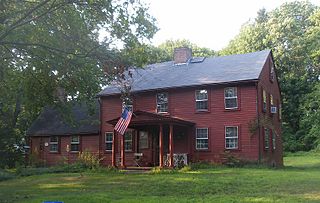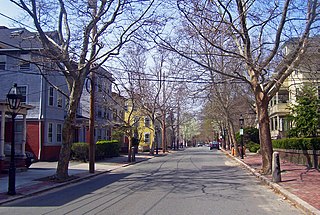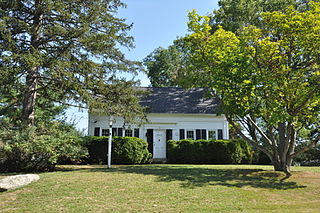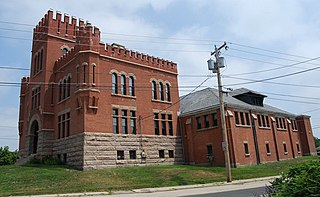
Oak Lawn or Oaklawn is a historical village in southwest Cranston, Rhode Island. Prior to being named "Oak Lawn" in 1872 the area was known as "Searle's Corner". The Edward Searle House, built in 1677, and one of the oldest standing structures in Rhode Island, is located in Oak Lawn. The village is known for its annual May Breakfast, a New England tradition that began in Oak Lawn in 1865 as a way for the members of the Oak Lawn Baptist Church to raise money for local American Civil War veterans. The 1855 Herman Melville novel "Israel Potter" is based on the life and adventures of an American Revolutionary soldier who was raised on a farm near present-day Oak Lawn. Oak Lawn is also the site of an important archeological excavation: in the 1950s archeologists discovered bowls and other Native American artifacts, carved from soapstone and dating back more than 10,000 years. In the pre-colonial era the area was populated with bands of the Narragansett Indians known as the "Meshanticut" and "Natick" Indians.

This is a list of properties and districts listed on the National Register of Historic Places in Rhode Island. As of May 29, 2015, there are more than 750 listed sites in Rhode Island. All 5 of the counties in Rhode Island have listings on the National Register.

Roger Williams Park is an elaborately landscaped 427-acre (173 ha) city park in Providence, Rhode Island and a historic district listed on the National Register of Historic Places. It is named after Roger Williams, the founder of the city of Providence and the primary founder of the state of Rhode Island.

The Eleazer Arnold House is a historic house built for Eleazer Arnold in about 1693, and located at 487 Great Road, Lincoln, Rhode Island in the Great Road Historic District. It is now a National Historic Landmark owned by Historic New England, and open to the public on weekends.

The College Hill Historic District is located on the East Side of Providence, Rhode Island, United States. It was designated a National Historic Landmark District on December 30, 1970. The College Hill local historic district, established in 1960, partially overlaps the national landmark district. Properties within the local historic district are regulated by the city's historic district zoning ordinance, and cannot be altered without approval from the Providence Historic District Commission.

The Portsmouth Friends Meetinghouse, Parsonage, and Cemetery is a historic Friends Meeting House and cemetery of the Religious Society of Friends (Quakers), at 11 Middle Road and 2232 E. Main Road in Portsmouth, Rhode Island.

The Arkwright Bridge is an abandoned historic bridge formerly carrying Hill Street over the Pawtuxet River in the Arkwright mill village in central Rhode Island. The river forms the border between Cranston and Coventry.

The Thomas Fenner House or the "Sam Joy Place" is an historic stone-ender house on 43 Stony Acre Drive in Cranston, Rhode Island. It is one of the oldest surviving houses in Rhode Island. The house was built as a farmhouse around 1677 after King Philip's War by Captain Arthur Fenner for his son Major Thomas Fenner. The house was added to the National Register of Historic Places in 1990. It is privately owned and is not open to the public.

The Joy Homestead, also known as the Job Joy House, is an historic house on Old Scituate Avenue in Cranston, Rhode Island. This 2 1⁄2-story gambrel-roof wood-frame house was built sometime between 1764 and 1778. It was occupied by members of the Joy family until 1884, and was acquired by the Cranston Historical Society in 1959. The house is believed to a stopping point on the first day's march in 1781 of the French Army troops en route from Providence to Yorktown during the American Revolutionary War.

The Norwood Avenue Historic District is a residential historic district in Cranston and Providence, Rhode Island. It includes all of the properties along Norwood Avenue between Broad Street in Cranston and Green Boulevard in Providence. The street is lined with houses built for the most part between 1890 and 1930, which are stylistically Queen Anne and Colonial Revival in character.

The Potter–Remingston House is an historic house just east of 571 Natick Road in Cranston, Rhode Island. It is a 2 1⁄2-story wood-frame structure, five bays wide, with a large central chimney, and a two-story ell attached to the west side. It is set on what was originally a 21-acre (8.5 ha) parcel of rolling woods and overgrown fields, adjacent to the Remington family cemetery. The outside of the house has relatively plain styling, but its interior public spaces include some elaborate Federal period woodwork. It is one of the few surviving 18th-century farm houses in Cranston.

The Arad Wood House is an historic house at 407 Pontiac Avenue in Cranston, Rhode Island. The 2 1⁄2-story wood-frame house was built c. 1858 for N. Thornton, and is one Cranston's finest Italianate houses. Although it was built as a farmhouse, it was acquired in the 1890s by Arad Wood, one of Cranston's wealthiest businessmen, who operated a gentleman's farm of several hundred acres. The house was also later the first home of the Cranston chapter of the American Red Cross.

The Nathan Westcott House is a historic house at 150 Scituate Avenue in Cranston, Rhode Island. This 1-1/2 story gambrel-roofed wood-frame house was built c. 1770 as a "half house", and extended about 20 years later, based on architectural evidence. The house was probably built by Nathan Westcott, a member of the locally prominent Westcott family, whose progenitor was among the area's early settlers. The house was later owned by the Joy family, whose homestead stands next door.

Westcote is a historic house at 101 Mountain Laurel Drive in Cranston, Rhode Island. This 1-1/2 story Greek Revival cottage was built c. 1843, and was originally located on Oaklawn Avenue before being moved to its present location. It was built by a member of the locally prominent Westcott family as a farmhouse, and is a well-preserved and little-altered example of vernacular Greek Revival style.

The Governor William Sprague Mansion is an historic mansion and museum at 1351 Cranston Street in Cranston, Rhode Island. The house was the birthplace of Governor William Sprague III and his nephew, Governor William Sprague IV.

The Westerly Armory is an historic National Guard armory building located on Railroad Avenue, west of downtown Westerly, Rhode Island.

The Wilbor House is a historic house museum at 548 West Main Road in Little Compton, Rhode Island, and currently serves as the headquarters of the Little Compton Historical Society. The property includes eight buildings of historical significance, six of which were part of the Wilbor farmstead, a complex that was used for farming between 1690 and 1955, when the property was acquired by the historical society. The house is a 2-1/2 story wood frame structure, whose oldest portion was probably a stone ender built by Samuel Wilbor, and whose western half was added c. 1740, giving it a Georgian appearance. The five farm outbuildings all date to the 19th century.

Rosedale Apartments are a historic apartment house at 1180 Narragansett Boulevard in Cranston, Rhode Island. This U-shaped apartment block stands overlooking Narragansett Bay, with three stories facing the street and four toward the bay. The Art Moderne structure was designed by Herbert R. Hunt and built in 1939-40. It is a rare statewide example of a large-scale building in this style, and was one of only a few built in Cranston before the Second World War.

The Edgewood Historic District–Shaw Plat is a residential historic district in the Edgewood neighborhood of northeastern Cranston, Rhode Island. It is bounded by Broad Street on the west, Marion Avenue on the south, and Narragansett Bay on the east; it consists of the properties that line the parallel streets, Shaw and Marion Avenues, and the short section of Narragansett Boulevard that runs between Shaw and Marion Avenues. On the north it abuts the separately-listed Edgewood Historic District–Arnold Farm Plat. The area was platted out between 1867 and 1895, with construction of most of its housing taking place between 1867 and the start of World War II, with the most construction going on between 1895 and 1930. The district also includes the previously listed Edgewood Yacht Club. In 1853, the 25 acres of land that became the Shaw Plat was sold to Allen Shaw of Providence for $3,660.
This is a list of Registered Historic Places in Cranston, Rhode Island.
























